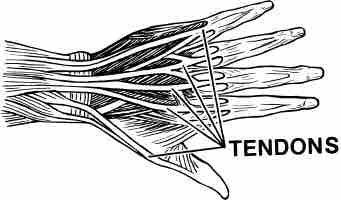Synovial joints are made up of five classes of tissues: bone, cartilage, synovium, synovial fluid, and tensile tissues composed of tendons and ligaments. The synovial lining in the bursae and tendon sheaths, similar to that within joints, is a slippery, non-adherent surface allowing movement between planes of tissue. Synovial tendon sheaths line tendons only where they pass through narrow passages or retinacula, as in the palm, at the wrist, and around the ankle. Elsewhere, the tendon lies in a bed of loose fibrous tissue.
A tendon or sinew is a tough band of fibrous connective tissue that usually connects muscle to bone and is capable of withstanding tension. Tendons are similar to ligaments and fasciae as they are all made of collagen, but a ligament joins one bone to another and fasciae connect muscles to other muscles. Tendons connect muscle to bone and move the bones or structures to which they are attached.

Tendons
Illustration of the location of tendons in the hand
A bursa (plural bursae) is a small, fluid-filled sac lined by synovial membrane with an inner capillary layer of fluid (synovial fluid) with the consistency of raw egg white. It provides a cushion between bones and tendons or muscles around a joint. This helps to reduce friction between the bones and allows for free movement.
Bursae occur at sites of shearing in subcutaneous tissue or between deeper tissues such as muscle groups and fascia. Many bursae develop during growth, but new or adventitious bursae can occur at sites of occupational friction. Bursae are found around most major joints of the body, such as the shoulder and the knee. For example, to protect the knee and reduce friction from the various muscles, tendons, and ligaments that attach to and cross the knee joint, knees are cushioned by 14 different bursae: five in front, four laterally, and five medially.
Bursa.jpg
Drawing of the knee joint showing bursae, ligaments, and tendons.